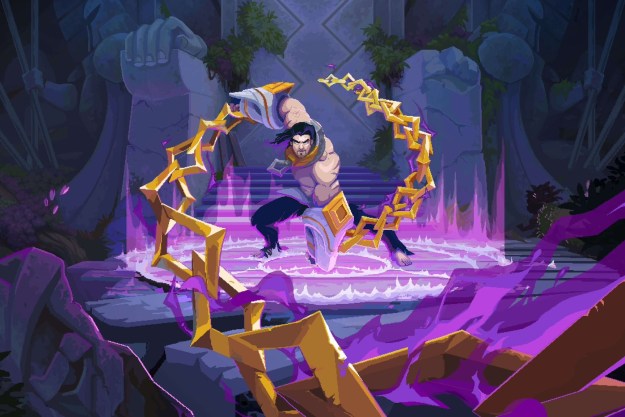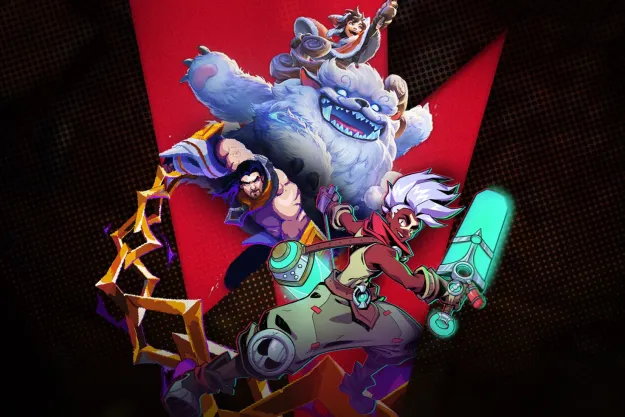League of Legends’ 5v5 MOBA mode is one of the most iconic multiplayer setups in gaming. It attracts millions of players every day, and millions of dollars are spent throwing and giving rewards for tournaments based on that formula. That’s why it’s exciting when Riot Games occasionally experiments with new modes that modify the core concept of League of Legends in unique ways. The latest mode to do this is the 2v2v2v2 Arena, which is coming to the game as part of this summer’s Soul Fighter event.
Channeling the energy of modes like Call of Duty: Modern Warfare’s Gunfight (a personal favorite of mine), Arena is a mode that distills that classics formula into quicker, more intense matches in smaller arenas. As someone who likes the world and lore of League of Legends but is hesitant to put in the hours required to learn and master the 5v5 competitive esport part of League of Legends, I was particularly intrigued when I got to check out what Riot Games has in store with Arena mode ahead of its release.
How Arena works
Arena matches consist of four teams of two players. Those teams will be able to blind ban certain Champions for all players in their match, but players on two different teams can still pick the same Champion. Before they fight, though, there’s a Shop Phase reminiscent of games like Teamfight Tactics or Valorant. Over 45 seconds, players will have the time to purchase Augments that can enhance their Champion and Juices that give round-specific boosts. After every player has bought what they want (or that timer runs out), the Combat Phase begins.

Two teams are transported to a randomly selected arena and then fight each other Champions until one team wins. During a match, players can also attack “Power Flowers” to gain boost things like health, shields, and cooldown time, and they will have to account for a slowly closing ring of fire around the edges of the maps. Each of the four teams starts Arena with 20 health, and they will lose two to eight points each time they lose a Combat Phase. Arena plays out in a round-robin format, so teams will continue to rotate opponents, buy things during the Shop Phase, and then face off in a Combat Phase until only one team remains.
Matches get more intense over time thanks to the Augments and Juices that players are buying, as well as a Cameo system that adds Champions like Evelynn and Naafiri to the Arena as battlefield hazards in later rounds. All of this will take place between just 10 to 15 minutes, too, so playing an arena match will be much less of a time-sink than spending nearly an hour on a traditional League of Legends match.
At its core, Arena looks like it won’t stray too far from the basic formula of the 5v5 matches League of Legends is known for (although there are no Runes). Still, these new arena elements are supposed to make players think differently about their positioning and how to deal with the other enemies’ abilities in every match. That’s a clever way for Riot Games to make something that feels fresh but stays mostly within mechanics that already exist within the game.
Designing Arena
Making a new mode for a popular game like League of Legends forces its developers to reassess certain Champions who weren’t designed with a 2v2 mode in mind. Speaking in a group Q&A ahead of Arena’s reveal, Design Lead Daniel Emmons discussed how giving arenas enough spacing so ranged characters are still viable was a big challenge.
“A lot of mechanics are intended to help out ranged Champion. Summoner’s Flee is a power that you can use to run away, which is traditionally not something that we like supporting in League,” Emmons says. “A lot of the design of the arenas was also involved in making sure that there weren’t pockets of vision, so we came up with things like the Deep Water mechanics that create a space that players can only see over to aim spells or auto attacks.”

Later, Emmons confirmed that Champions with stacking mechanics intertwined with their abilities would passively gain stacks as an Arena match progresses. Environmental effects like the Cameos, Power Flowers, and the closing ring of fire were also added to ensure that some Champions are pushed out of their comfort zones but still viable in different ways. Currently, Riot Games intend to have all Champions enabled in Arenas, although that might change if issues are encountered in QA before the mode’s release.
Emmons even admits that Arenas may not “be as polished as we want because we really wanted to respond to the player feedback and get something out for summer.” Still, once it’s out, a lot of time will have to be spent balancing the mode as well. Currently, Arena is confirmed to be live for the six weeks that the Soul Fighter event takes place during League of Legends. After that, Arena Product Manager Eduardo Cortejoso says Riot will analyze player feedback and “go back to the drawing board and try to understand how we can push Arena into the direction where we’re going to be confident about its potential longer-term future, whether that is a permanent game mode or a new rotating game mode that comes back every once in a while.”
Still, as someone who likes the world of Runeterra but hasn’t been enthralled by League of Legends itself, the shorter, more intense matches of Arena are certainly enticing me to give the MOBA a shot. The best-case scenario for Arena is that it does that for a lot of other players two, and this becomes a new way to experience League of Legends alongside the 5v5 MOBA formula Riot Games has refined and mastered over the past decade.
Editors' Recommendations
- League of Legends isn’t as big of a dating don’t as you may think
- Bandle Tale: A League of Legends Story is a bittersweet eulogy for Riot Forge
- Bandle Tale is unlike anything you’ve seen in the League of Legends universe
- Riot Forge explains why Bandle Tale is a perfect fit for its developer
- Watch a full match of League of Legends fighting game Project L




